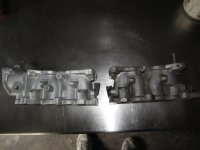sbaugz
DTT BOTM winner
I have sandblasting equipment and have done that regularly. I have never glass beaded anything.
Rather than buy bead blast media myself, there is a place locally that rents glass bead blasting time at their cabinets by the minute at their facility.
I have a pair of bare crank cases that I want to get clean. Everything is removed from the crankcases. Was thinking glass bead blasting would do the trick and I could leave them bare after the bead blasting. Its the crank cases from a T500. There really aren't any passageways or areas to trap the beads. My biggest concern are the inside surfaces where the crank bearings, gear shift bearings, kickstart bearings, etc make contact with the crankcase covers. I would assume I don't want to bead blast these areas? If not, how do I protect them?
I was under the impression that glass bead blasting doesn't change the surface of the metal and you don't lose any metal material in the process? Maybe I am wrong? looking for advice on how to prep and blast these cases properly. Thanks.
Rather than buy bead blast media myself, there is a place locally that rents glass bead blasting time at their cabinets by the minute at their facility.
I have a pair of bare crank cases that I want to get clean. Everything is removed from the crankcases. Was thinking glass bead blasting would do the trick and I could leave them bare after the bead blasting. Its the crank cases from a T500. There really aren't any passageways or areas to trap the beads. My biggest concern are the inside surfaces where the crank bearings, gear shift bearings, kickstart bearings, etc make contact with the crankcase covers. I would assume I don't want to bead blast these areas? If not, how do I protect them?
I was under the impression that glass bead blasting doesn't change the surface of the metal and you don't lose any metal material in the process? Maybe I am wrong? looking for advice on how to prep and blast these cases properly. Thanks.





